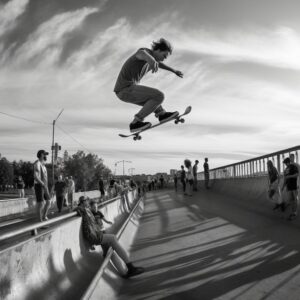Skateboarding has always been a sport that requires a great deal of skill and practice. Over the years, skaters have developed some incredibly difficult tricks that require a combination of balance, precision, and bravery to pull off. Here are five of the hardest skateboard tricks in existence:
- The Laser Flip: The Laser Flip is a combination of a kickflip and a heelflip, with the board flipping in a 360-degree rotation. This trick requires perfect timing, balance, and control to land successfully.
- The Varial Heelflip: The Varial Heelflip is another complex trick that combines a heelflip and a pop-shove it. This trick requires a great deal of skill to execute, as the skater must flip the board and spin it at the same time.
- The 360 Flip: The 360 Flip, also known as the tre flip, is a combination of a kickflip and a 360-degree spin. This trick requires a great deal of precision and control, as the board must flip and spin at the same time.
- The Double Flip: The Double Flip is a combination of two kickflips in a row. This trick requires incredible timing and coordination, as the skater must flip the board twice while also controlling their body in mid-air.
- The Impossibles: The Impossibles are a series of tricks where the skater pops the board up into the air and then flicks it with their back foot in a way that makes it spin under their front foot. This trick requires perfect timing and control, as the board must spin around the skater’s front foot before they catch it and land.

These are just a few examples of the most difficult skateboard tricks out there. Of course, there are many other incredibly challenging tricks that skaters are constantly pushing themselves to master.
As for the history of skateboarding, the sport has come a long way since its humble beginnings in the 1950s. Skateboarding has gone from being a pastime for surfers to a global phenomenon, with millions of people around the world participating in the sport. Skateparks have become more advanced and elaborate, providing skaters with more opportunities to practice and compete.
In the 1960s, skateboarding began to gain popularity as a standalone sport. Skateboard manufacturers began to produce more advanced boards, with trucks and wheels designed specifically for skateboarding. Skateparks also began to appear, providing skaters with a place to practice their skills and compete with each other.
In the 1970s, skateboarding continued to evolve, with skaters experimenting with new tricks and techniques. The introduction of the urethane wheel revolutionized skateboarding, making it possible for skaters to achieve greater speeds and perform more complex maneuvers.
Throughout the 1980s and 1990s, skateboarding continued to gain popularity, with skateboarding competitions and events drawing large crowds of spectators. Skaters like Tony Hawk and Rodney Mullen became household names, and skateboarding began to be recognized as a legitimate sport.
Despite its evolution over the years, skateboarding has always remained true to its roots. Skaters continue to push the boundaries of what is possible, developing new tricks and techniques that amaze and inspire us all. And while the sport may have its difficult moments, it remains one of the most exciting and rewarding activities out there.


0 Comments